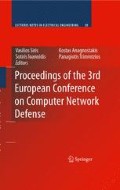Abstract
This paper provides a new framework for efficient detection and identification of network anomalies over high speed links, in early stage of its occurrence to quickly react by taking the appropriate countermeasures. The proposed framework is based on change point detection in counters value of reversible sketch, which aggregates multiple data streams from high speed links in a stretched database. To detect network anomalies, we apply the cumulative sum (CUSUM) algorithm at the counter value of each bucket in the proposed reversible sketch, to detect change point occurrence and to uncover culprit flows via a new approach for sketch inversion. Theoretical framework for attacks detection is presented. We also give the results of our experiments analysis over two real data traces containing anomalies, and extensively analyzed in OSCAR French research project. Our analysis results from real-time internet traffic and online implementation over Endace DAG 3.6ET card show that our proposed architecture is able to detect culprit flows quickly with a high level of accuracy.
Access this chapter
Tax calculation will be finalised at checkout
Purchases are for personal use only
Preview
Unable to display preview. Download preview PDF.
References
Charikar M, Chen K, Farach-Colton M (2002) Finding frequent items in data streams. In: 29th International Colloquium on Automata, Languages and Programming (ICALP ’02), London, UK, pp. 693–703.
Cisco Systems Inc: Cisco netflow. http://www.cisco.com/wrap/public/732/Tech/netflow
Cormode G, Korn F, Muthukrishnan S, Srivastava D (2004) Diamond in the rough: Finding hierarchical heavy hitters in multi-dimensional data. In: 23rd ACM SIGMOD, pp. 155–166.
Cormode G, Muthukrishnan S (2004) What’s new: Finding significant differences in network data streams. In: IEEE Infocom’04, pp. 1534–1545.
Cormode G, Muthukrishnan S (2005). An improved data stream summary: The count-min sketch and its applications. Journal of Algorithms, 55(1):58–75.
Feng W, Zhang Z, Jia Z., Fu Z (2006). Reversible sketch based on the xor-based hashing. In: Asia-Pacific Conference on Services Computing (APSCC ’06), Guangzhou, Guangdong, China, pp. 93–98.
Fluhrer S, McGrew D (2001). Statistical analysis of the alleged RC4 keystream generator. In: 7th International Workshop on Fast Software Encryption (FSE ’00), London, UK, pp. 19–30.
Gutmann P (1996), Optimized RC4 code. http://www.zengl.net/freeswan/.
Jung J, Paxson V, Berger A, Balakrishnan H (2004) Fast portscan detection using sequential hypothesis testing, in: IEEE Symposium on Security and Privacy, pp. 9–12.
Kim H, Rozovskii B, Tartakovsky A (2004) A nonparametric multichart cusum test for rapid intrusion detection. Journal of Computing and Information Science, 2(3):149–158.
Krishnamurthy B, Sen S, Zhang Y, Chen Y (2003) Sketch-based change detection: methods, evaluation, and applications. In: 3rd ACM SIGCOMM Conference on Internet Measurement (IMC’03), New York, USA, pp. 234–247.
Li X, Bian F, Crovella M, Diot C, Govindan R, Iannaccon G, Lakhina A (2006) Detection and identification of network anomalies using sketch subspaces. In: 6th ACM SIGCOMM on Internet Measurement (IMC ’06), New York, USA, pp. 147–152.
Li Y, Yang J, An C, Zhang H (2007) Finding hierarchical heavy hitters in network measurement system. In: ACM Symposium on Applied Computing (SAC ’07), New York, USA, pp. 232–236.
Massive Data Analysis Lab: MassDal: Count-min sketch source code. http://www.cs.rutgers.edu/7Emuthu/massdal-code-index.html
Moore D, Voelker G, Savage S (2001) Inferring internet denial-of-service activity. In: Usenix Security Symposium, pp. 9–22.
National Laboratory of Applied Network Research: NLANR: Traces archive. http://pma.nlanr.net/Special/.
Paxson V (1999). Bro: A system for detecting network intruders in real-time. Journal of Computer Networks, 31(23–24):2435–2463.
Roesch M (1999) Snort – lightweight intrusion detection for networks. In: USENIX Lisa ’99, Seattle, WA, USA.
Schweller R, Li Z, Chen Y, Gao Y, Gupta A, Parsons E, Zhang Y, Dinda P, Kao M.-Y, Memik G (2006) Reverse hashing for high-speed network monitoring: Algorithms, evaluation, and applications. In: INFOCOM 06, pp. 1–12.
Siris V. A, Papagalou F (2004) Application of anomaly detection algorithms for detecting Syn flooding attacks. In: GLOBECOM ’04, vol 4, Dallas, USA, pp. 2050–2054.
Tartakovsky A (2005) Asymptotic performance of a multichart cusum test under false alarm probability constraint. In: 44th IEEE Conference on Decision and Control and the European Control Conference, Seville, Spain, pp. 320–325.
Tartakovsky A, Rozovskii B, Blazek R, Kim H (2006) A novel approach to detection of intrusions in computer networks via adaptive sequential and batch-sequential change-point detection methods. Journal of IEEE Transactions on Signal Processing, 54(9):3372–3382.
Thorup M, Zhang Y (2004) Tabulation based 4-universal hashing with applications to second moment estimation. In: ACM-SIAM Symposium on Discrete Algorithms (SODA ’04), New Orleans, LA, USA.
Wang H, Zhang D, Shin K. G (2002) Syn-dog: Sniffing syn flooding sources. In: 22nd International Conference on Distributed Computing Systems (ICDCS’02), Washington, DC, USA, pp. 421–429.
Author information
Authors and Affiliations
Corresponding author
Editor information
Editors and Affiliations
Rights and permissions
Copyright information
© 2008 Springer Science+Business Media, LLC
About this paper
Cite this paper
Salem, O., Vaton, S., Gravey, A. (2008). A Novel Approach for Anomaly Detection over High-Speed Networks. In: Siris, V., Anagnostakis, K., Ioannidis, S., Trimintzios, P. (eds) Proceedings of the 3rd European Conference on Computer Network Defense. Lecture Notes in Electrical Engineering, vol 30. Springer, Boston, MA. https://doi.org/10.1007/978-0-387-85555-4_4
Download citation
DOI: https://doi.org/10.1007/978-0-387-85555-4_4
Publisher Name: Springer, Boston, MA
Print ISBN: 978-0-387-85554-7
Online ISBN: 978-0-387-85555-4
eBook Packages: EngineeringEngineering (R0)

